
Prestressed Concrete
Since concrete is weak in tension in normal reinforced concrete construction cracks develop in
the tension zone at working loads and therefore all concrete
in tension is ignored in design.
Prestressing involves inducing compressive stresses in the
zone which will tend to become tensile under external loads.
This compressive stress neutralizes the tensile stress so
that no resultant tension exists, (or only very small
values, within the tensile strength of the concrete).
Cracking is therefore eliminated under working load and all
of the concrete may be assumed effective in carrying load.
Therefore lighter sections may be used to carry a given
bending moment, and prestressed concrete may be used over
much longer spans than reinforced concrete.
The prestressing force also reduces the magnitude of the
principal tensile stress in the web so that thin-webbed Ι
- sections may be used without the risk of diagonal tension
failures and with further savings in self-weight.
The prestressing force has to be produced by a high tensile
steel, and it is necessary to use high quality concrete to
resist the higher compressive stresses that are developed.
There are two methods of
prestressing concrete :
1) Pre-cast Pre-tensioned
2) Pre-cast Post-tensioned
Both methods involve tensioning cables inside a concrete
beam and then anchoring the stressed cables to the concrete.
1) Pre-tensioned Beam Construction
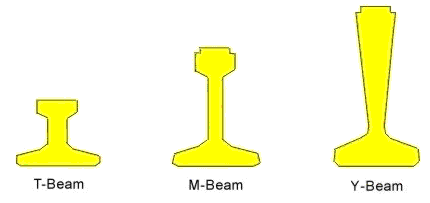
Stage 1
Tendons and reinforcement are positioned in the beam mould.
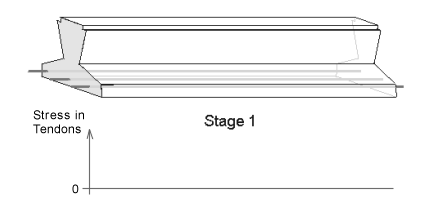
Stage 2
Tendons are stressed to about 70% of their ultimate strength.
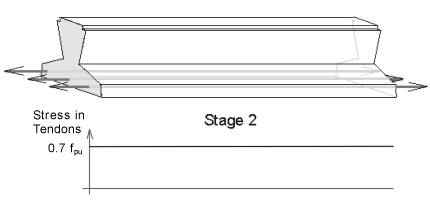
Stage 3
Concrete is cast into the beam mould and allowed to cure to the required initial strength.

Stage 4
When the concrete has cured the stressing force is released and the tendons anchor themselves in
the concrete.
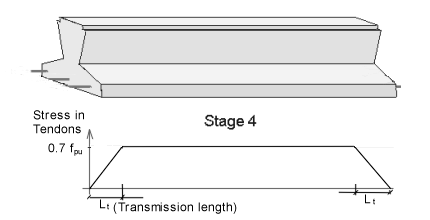
Stage 5
Loss of prestress due to elastic deformation of the concrete and relaxation of the steel need to be considered. Further loss of prestress will also occur due to shrinkage and creep of the concrete; as these are time related then the effects will need to be considered both at short term and long term.
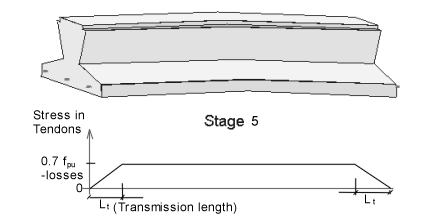
2) Post-tensioned Beam Construction

Stage 1
Cable ducts and reinforcement are positioned in the beam mould. The ducts are usually raised towards the neutral axis at the ends to reduce the eccentricity of the stressing force

Stage 2
Concrete is cast into the beam mould and allowed to cure to the required initial strength.

Stage 3
Tendons are threaded through the cable ducts and tensioned to about 70% of their ultimate strength. The diagram above indicates jacking from both ends of the beam.

Stage 4
a) Wedges are inserted into the end anchorages,
b) the tensioning force on the tendons is released. Grout is then pumped into the ducts to protect the tendons.
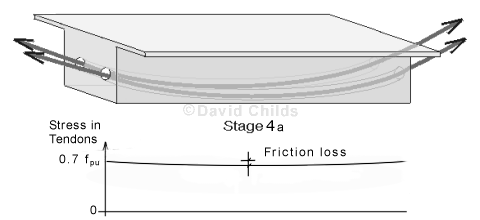
Stage 5
Loss of prestress due to elastic deformation of the concrete and relaxation of the steel need to be considered. Further loss of prestress will also occur due to shrinkage and creep of the concrete; as these are time related then the effects will need to be considered both at short term and long term.

Loss of Prestress
Total losses in prestress can amount to about 30% of the initial tensioning stress.
In pre-tensioned beams the losses comprise:
- Elastic deformation of concrete
- Relaxation of stress in the tendons
- Shrinkage of concrete
- Creep of concrete
In post-tensioned beams the losses comprise:
- Elastic deformation of concrete unless all tendons are tensioned simultaneously
- Relaxation of stress in the tendons
- Shrinkage of concrete
- Creep of concrete
- Friction between the ducts and tendons
- Movement of the tendons at the anchorage during transfer of the prestressing force from the tensioning equipment to the achorage
Contact David Childs

